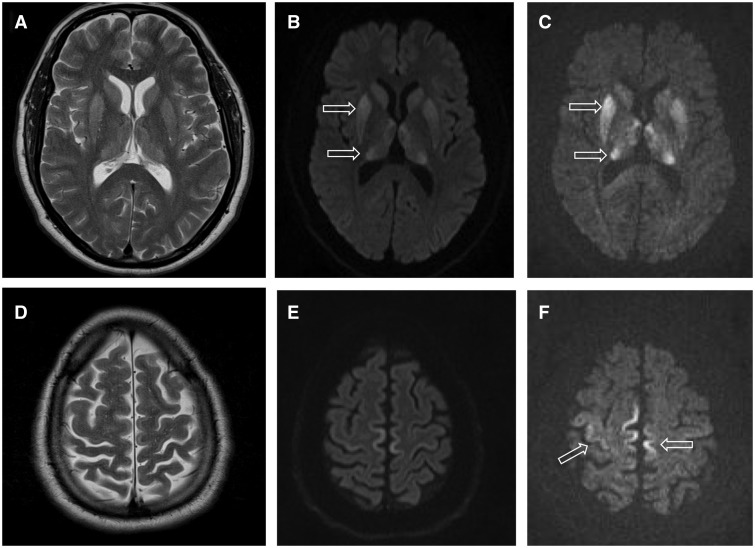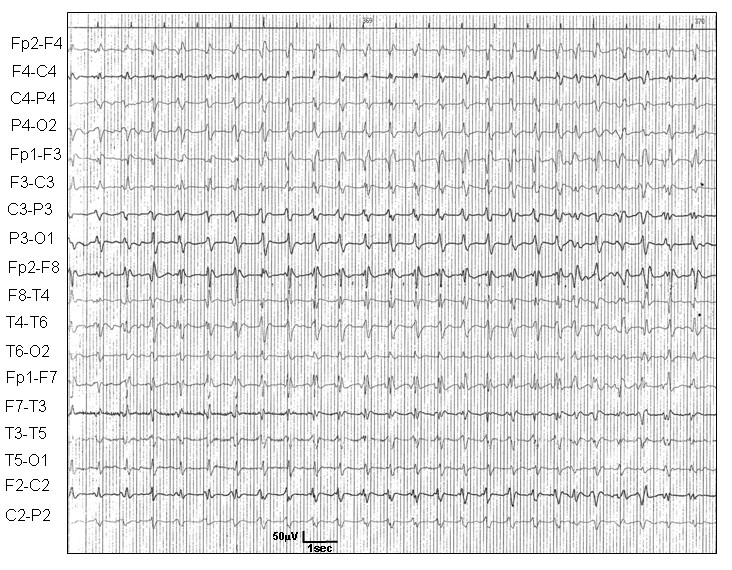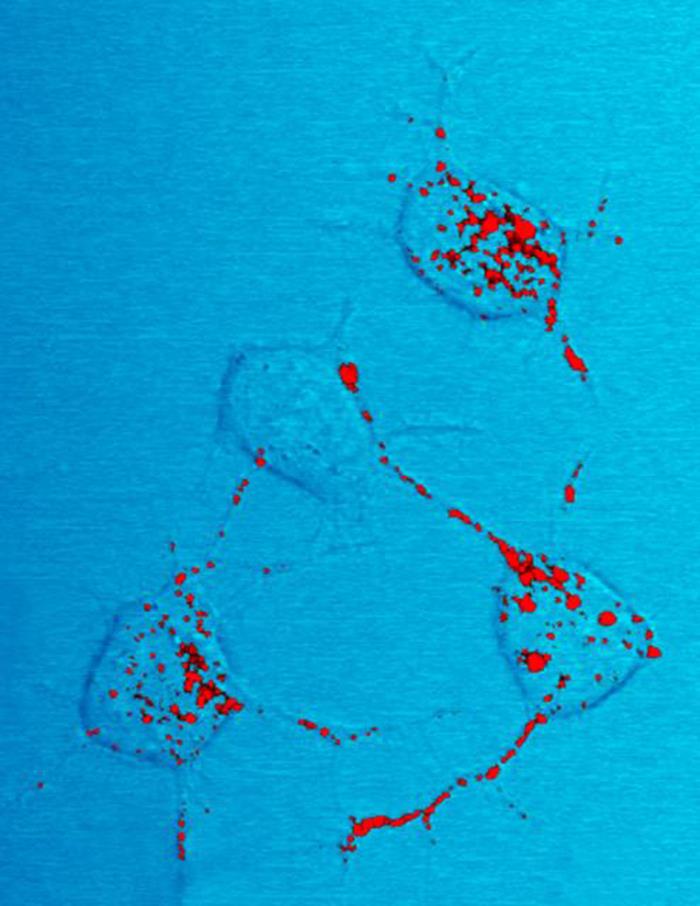|
Creutzfeldt–Jakob Disease
Creutzfeldt–Jakob disease (CJD) is an incurable, always fatal neurodegenerative disease belonging to the transmissible spongiform encephalopathy (TSE) group. Early symptoms include memory problems, behavioral changes, poor coordination, visual disturbances and auditory disturbances. Later symptoms include dementia, involuntary movements, blindness, deafness, weakness, and coma. About 70% of sufferers die within a year of diagnosis. The name "Creutzfeldt–Jakob disease" was introduced by Walther Spielmeyer in 1922, after the German neurologists Hans Gerhard Creutzfeldt and Alfons Maria Jakob. CJD is caused by abnormal folding of a protein known as a prion. Infectious prions are misfolded proteins that can cause normally folded proteins to also become misfolded. About 85% of cases of CJD occur for unknown reasons, while about 7.5% of cases are inherited in an autosomal dominant manner. Exposure to brain or spinal tissue from an infected person may also result in spread. Ther ... [...More Info...] [...Related Items...] OR: [Wikipedia] [Google] [Baidu] |
Magnetic Resonance Imaging
Magnetic resonance imaging (MRI) is a medical imaging technique used in radiology to generate pictures of the anatomy and the physiological processes inside the body. MRI scanners use strong magnetic fields, magnetic field gradients, and radio waves to form images of the organs in the body. MRI does not involve X-rays or the use of ionizing radiation, which distinguishes it from computed tomography (CT) and positron emission tomography (PET) scans. MRI is a medical application of nuclear magnetic resonance (NMR) which can also be used for imaging in other NMR applications, such as NMR spectroscopy. MRI is widely used in hospitals and clinics for medical diagnosis, staging and follow-up of disease. Compared to CT, MRI provides better contrast in images of soft tissues, e.g. in the brain or abdomen. However, it may be perceived as less comfortable by patients, due to the usually longer and louder measurements with the subject in a long, confining tube, although ... [...More Info...] [...Related Items...] OR: [Wikipedia] [Google] [Baidu] |
Supportive Care
Symptomatic treatment, supportive care, supportive therapy, or palliative treatment is any medical therapy of a disease that only affects its symptoms, not the underlying cause. It is usually aimed at reducing the signs and symptoms for the comfort and well-being of the patient, but it also may be useful in reducing organic consequences and sequelae of these signs and symptoms of the disease. In many diseases, even in those whose etiologies are known (e.g., most viral diseases, such as influenza and Rift Valley fever), symptomatic treatment is the only treatment available so far. For more detail, see supportive therapy. For conditions like cancer, arthritis, neuropathy, tendinopathy, and injury, it can be useful to distinguish treatments that are supportive/palliative and cannot alter the natural history of the disease ( disease modifying treatments). Examples Examples of symptomatic treatments: * Analgesics, to reduce pain * Anti-inflammatory agents, for inflammatio ... [...More Info...] [...Related Items...] OR: [Wikipedia] [Google] [Baidu] |
Variant Creutzfeldt–Jakob Disease
Variant Creutzfeldt–Jakob disease (vCJD), formerly known as new variant Creutzfeldt–Jakob disease (nvCJD) and referred to colloquially as "mad cow disease" or "human mad cow disease" to distinguish it from its BSE counterpart, is a fatal type of brain disease within the transmissible spongiform encephalopathy family. Initial symptoms include psychiatric problems, behavioral changes, and painful sensations. In the later stages of the illness, patients may exhibit poor coordination, dementia and involuntary movements. The length of time between exposure and the development of symptoms is unclear, but is believed to be years to decades. Average life expectancy following the onset of symptoms is 13 months. It is caused by prions, which are misfolded proteins. Spread is believed to be primarily due to eating beef infected with bovine spongiform encephalopathy (BSE). Infection is also believed to require a specific genetic susceptibility. Spread may potentially also occu ... [...More Info...] [...Related Items...] OR: [Wikipedia] [Google] [Baidu] |
Blood Transfusions
Blood transfusion is the process of transferring blood products into a person's circulation intravenously. Transfusions are used for various medical conditions to replace lost components of the blood. Early transfusions used whole blood, but modern medical practice commonly uses only components of the blood, such as red blood cells, plasma, platelets, and other clotting factors. White blood cells are transfused only in very rare circumstances, since granulocyte transfusion has limited applications. Whole blood has come back into use in the trauma setting. Red blood cells (RBC) contain hemoglobin and supply the cells of the body with oxygen. White blood cells are not commonly used during transfusions, but they are part of the immune system and also fight infections. Plasma is the "yellowish" liquid part of blood, which acts as a buffer and contains proteins and other important substances needed for the body's overall health. Platelets are involved in blood clotting, prev ... [...More Info...] [...Related Items...] OR: [Wikipedia] [Google] [Baidu] |
Autosomal Dominant
In genetics, dominance is the phenomenon of one variant (allele) of a gene on a chromosome masking or overriding the Phenotype, effect of a different variant of the same gene on Homologous chromosome, the other copy of the chromosome. The first variant is termed dominant and the second is called recessive. This state of having Heterozygosity, two different variants of the same gene on each chromosome is originally caused by a mutation in one of the genes, either new (''de novo'') or Heredity, inherited. The terms autosomal dominant or autosomal recessive are used to describe gene variants on non-sex chromosomes (autosomes) and their associated traits, while those on sex chromosomes (allosomes) are termed X-linked dominant, X-linked recessive or Y-linked; these have an inheritance and presentation pattern that depends on the sex of both the parent and the child (see Sex linkage). Since there is only one Y chromosome, Y-linked traits cannot be dominant or recessive. Additionally, ... [...More Info...] [...Related Items...] OR: [Wikipedia] [Google] [Baidu] |
Prion
A prion () is a Proteinopathy, misfolded protein that induces misfolding in normal variants of the same protein, leading to cellular death. Prions are responsible for prion diseases, known as transmissible spongiform encephalopathy (TSEs), which are fatal and transmissible neurodegenerative diseases affecting both humans and animals. These proteins can misfold sporadically, due to genetic mutations, or by exposure to an already misfolded protein, leading to an abnormal Protein tertiary structure, three-dimensional structure that can propagate misfolding in other proteins. The term ''prion'' comes from "proteinaceous infectious particle". Unlike other infectious agents such as viruses, bacteria, and fungi, prions do not contain nucleic acids (DNA or RNA). Prions are mainly twisted Protein isoform, isoforms of the major prion protein (PrP), a naturally occurring protein with an uncertain function. They are the hypothesized cause of various transmissible spongiform encephalopath ... [...More Info...] [...Related Items...] OR: [Wikipedia] [Google] [Baidu] |
Who Named It
''Whonamedit?'' is an online English-language dictionary of medical eponyms and the people associated with their identification. Though it is a dictionary, many eponyms and persons are presented in extensive articles with comprehensive bibliographies. The dictionary is hosted in Norway Norway, officially the Kingdom of Norway, is a Nordic countries, Nordic country located on the Scandinavian Peninsula in Northern Europe. The remote Arctic island of Jan Mayen and the archipelago of Svalbard also form part of the Kingdom of ... and was developed by medical historian Ole Daniel Enersen. References External links * Medical websites Medical dictionaries Eponyms in medicine {{online-dict-stub ... [...More Info...] [...Related Items...] OR: [Wikipedia] [Google] [Baidu] |
Alfons Maria Jakob
Alfons Maria Jakob (2 July 1884 – 17 October 1931) was a German neurologist who worked in the field of neuropathology. He was born in Aschaffenburg, Bavaria and educated in medicine at the universities of Munich, Berlin, and Strasbourg, where he received his doctorate in 1908. During the following year, he began clinical work under the psychiatrist Emil Kraepelin and did laboratory work with Franz Nissl and Alois Alzheimer in Munich.Alfons Maria Jakob at Who Named It In 1911, by way of an invitation from Wilhelm Weygandt, [...More Info...] [...Related Items...] OR: [Wikipedia] [Google] [Baidu] |
Hans Gerhard Creutzfeldt
Hans Gerhard Creutzfeldt (June 2, 1885 – December 30, 1964) was a German neurologist and neuropathologist. Although he is typically credited as the physician to first describe the Creutzfeldt–Jakob disease, this has been disputed. He was born in Harburg an der Elbe and died in Munich. Biography Creutzfeldt was born into a medical family, on June 2, 1885, at Harburg an der Elbe, Germany, which was incorporated into Hamburg in 1937. In 1903, at the age of 18, he was drafted into the German army and spent his service stationed in Kiel. Afterwards, he attended the School of Medicine of the University of Jena and the University of Rostock, receiving his doctorate at the latter in 1909. Part of his practical training was undertaken at ''St. Georg'' – Hospital in Hamburg. After qualification he sought adventure as a ship's surgeon, voyaging the Pacific Ocean, taking the opportunity to study local crafts, linguistics, and tropical plants. After returning to Germany in 1912, ... [...More Info...] [...Related Items...] OR: [Wikipedia] [Google] [Baidu] |
Walther Spielmeyer
Walther Spielmeyer (23 April 1879 – 6 February 1935) was a German neuropathologist who was a native of Dessau. Biography He studied medicine at the University of Halle as a student of Eduard Hitzig (1838-1907). At Halle he was influenced by the work of psychiatrists Karl Heilbronner (1869-1914), Gustav Aschaffenburg (1866-1944) and pathologist Karl Joseph Eberth (1835-1926). In 1906 he relocated to Freiburg as an assistant to Alfred Hoche (1865-1943). At the suggestion of Emil Kraepelin (1856-1926), he succeeded Alois Alzheimer (1864-1915) as director of the ''Anatomisches Laboratorium der Psychiatrischen und Nervenklinik'' in Munich. At Munich he worked with Franz Nissl (1860-1919) and Felix Plaut (1877-1940). In 1928 the Rockefeller Foundation financed the Kaiser Wilhelm Institute with Spielmeyer as director of the ''Hirnpathologisches Institut''. He died of pulmonary tuberculosis on February 6, 1935. Research Spielmeyer is remembered for his research of peripheral ... [...More Info...] [...Related Items...] OR: [Wikipedia] [Google] [Baidu] |
Transmissible Spongiform Encephalopathy
Transmissible spongiform encephalopathies (TSEs), also known as prion diseases, are a group of progressive, incurable, and fatal conditions that are associated with the prion hypothesis and affect the brain and nervous system of many animals, including humans, cattle, and sheep. According to the most widespread hypothesis, they are transmitted by prions, though some other data suggest an involvement of a ''Spiroplasma'' infection. Mental and physical abilities deteriorate and many tiny holes appear in the cortex causing it to appear like a sponge when brain tissue obtained at autopsy is examined under a microscope. The disorders cause impairment of brain function which may result in memory loss, personality changes, and abnormal or impaired movement which worsen over time. TSEs of humans include Creutzfeldt–Jakob disease, Gerstmann–Sträussler–Scheinker syndrome, fatal familial insomnia, and kuru, as well as the recently discovered variably protease-sensitive prionopat ... [...More Info...] [...Related Items...] OR: [Wikipedia] [Google] [Baidu] |
Neurodegenerative Disease
A neurodegenerative disease is caused by the progressive loss of neurons, in the process known as neurodegeneration. Neuronal damage may also ultimately result in their death. Neurodegenerative diseases include amyotrophic lateral sclerosis, multiple sclerosis, Parkinson's disease, Alzheimer's disease, Huntington's disease, multiple system atrophy, tauopathies, and prion diseases. Neurodegeneration can be found in the brain at many different levels of neuronal circuitry, ranging from molecular to systemic. Because there is no known way to reverse the progressive degeneration of neurons, these diseases are considered to be incurable; however research has shown that the two major contributing factors to neurodegeneration are oxidative stress and inflammation. Biomedical research has revealed many similarities between these diseases at the subcellular level, including atypical protein assemblies (like proteinopathy) and induced cell death. These similarities suggest that therap ... [...More Info...] [...Related Items...] OR: [Wikipedia] [Google] [Baidu] |




